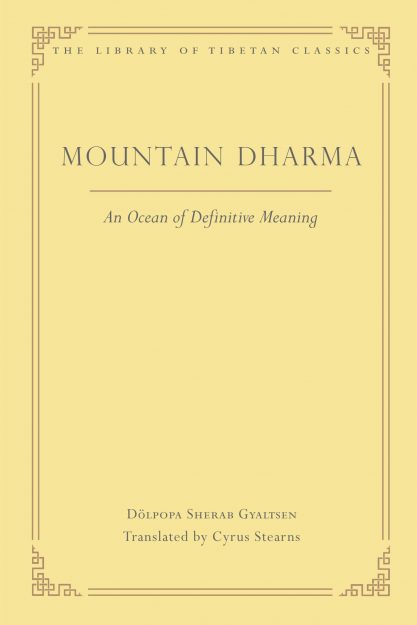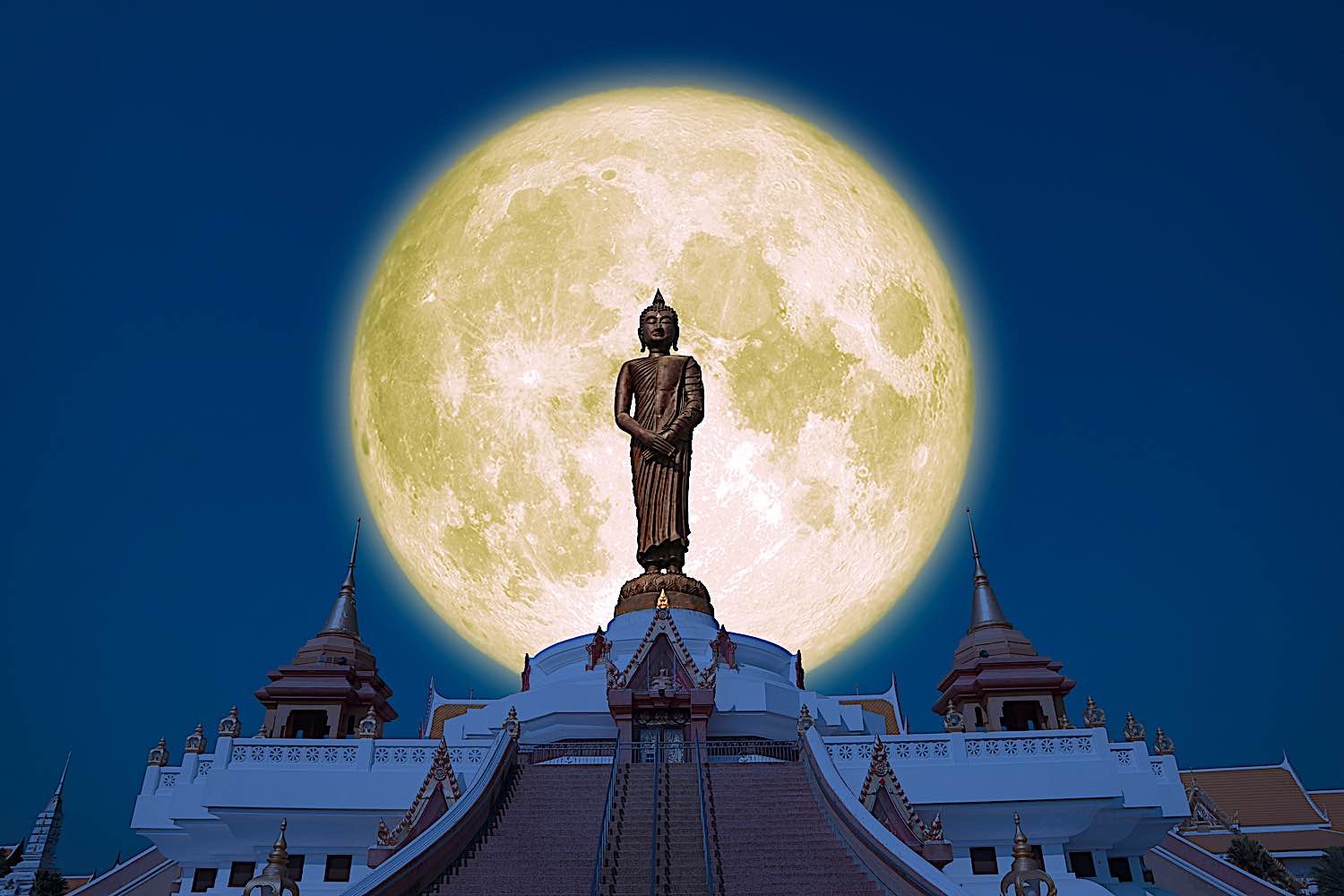The Philosophy of Other-Emptiness
The life and controversial teachings of Dölpopa Sherab Gyaltsen The post The Philosophy of Other-Emptiness appeared first on Tricycle: The Buddhist Review.

Buddhist philosophers have long been distinguished for their sophisticated analysis of emptiness (Skt.: sunyata). According to the concept of emptiness, words such as “car” or “tree” are helpful labels, but they do not refer to entities that have independent existence. Such terms are “empty” because they are imputed or overlaid on the variety of parts that make up an object. The mind and self are also empty in this way because they do not exist outside of relational, interdependent processes; they are not permanent. For Mahayana thinkers, all phenomena are generally considered empty.
For the Tibetan philosopher Dölpopa Sherab Gyaltsen (1292–1361), however, ultimate truth is empty only of “other,” the conventionally existing phenomena that appear in the world. In line with mainstream Mahayana thought, he held that external objects like trees and tables are empty. But beyond this, Dölpopa claimed that awareness itself—what he called the luminosity of mind or buddha-nature—is permanent. He termed this view “other-emptiness” (Tib.: zhentong): Ultimate reality is empty of relative phenomena but not of its own intrinsic existence. Critics saw this as an essentialist position, arguing that a permanent ultimate contradicts core Buddhist teachings. Dölpopa defended his position with citations from Indian scriptures, sparking major controversy in 14th-century Tibetan philosophy.
***
Dölpopa, “the one from Dölpo,” was born in this high-altitude region of present-day Nepal. As a novice monk, he followed his teacher Kyiton Gyeltsen to Sakya Monastery, in central Tibet, where he received instruction on buddha-nature, the Five Treatises of Maitreya, and the Kalachakra Tantra. Later in life, the Buddhist doctrines emphasized in these works informed his controversial teaching on other-emptiness.
In his 20s and early 30s, Dölpopa traveled widely throughout central Tibet. He studied with masters from various Tibetan Buddhist schools, including the 3rd Karmapa, Rangjung Dorje (1284–1339). He often returned to Sakya and Jonang monasteries, where he was held in particularly high esteem. Dölpopa completed a series of retreats at Jonang under the guidance of his teacher Yönten Gyatso (1260–1327), and in 1326 he accepted an offer to serve as abbot.
The following year, Yönten Gyatso passed away, and Dölpopa summoned numerous artisans and craftsmen from Nepal to build a large stupa in his honor. Dölpopa helped in the construction, likening the stupa to the center point of Buddhist cosmology and declaring it the inspiration for his philosophical insights: “The raising of Mount Meru has caused the ocean to gush forth,” he writes. The resulting oceanic output was his magnum opus, Mountain Dharma: An Ocean of Definitive Meaning, in which he introduces the idea of other-emptiness.
Dölpopa claimed that awareness itself—what he called the luminosity of mind or buddha-nature—is permanent. He termed this view “other-emptiness.”
Even with great inspiration, a lengthy treatise does not rush out fully formed. As noted by the recent translator of Mountain Dharma, Cyrus Stearns, Dölpopa worked on this text for years, drawing from his encyclopedic knowledge of Indian philosophical and tantric scriptures to demonstrate that other-emptiness had a solid footing in Buddhist tradition. (In this regard, it is telling that he does not cite a single Tibetan Buddhist text.) Dölpopa finished his work in 1334 or 1335, soon after a new set of translations of the Kalachakra Tantra were completed at Jonang. Indeed, Dölpopa refers to this influential scripture numerous times in Mountain Dharma.
Dölpopa’s biographers indicate that he continued to teach throughout the rest of his life in central Tibet. Even though he did not teach in a polemical manner, his teachings were controversial, especially when they departed from mainstream views on emptiness. Nevertheless, his presence attracted large audiences, and he was a beloved figure for many in the final decades of his life. In 1361, on the fourth day of the eleventh lunar month, Dölpopa passed away at Jonang Monastery, the place where he had done so much of his scholarship and teaching.
Among Dölpopa’s many treatises, Mountain Dharma best reflects his breadth of knowledge and insight. The work is organized according to three common Mahayana Buddhist principles: the ground, path, and fruition. Each section below explains one of these themes, and provides a corresponding passage from the text.
***
In Mountain Dharma: An Ocean of Definitive Meaning, Dölpopa begins by explaining that the ultimate truth is none other than buddha-nature or, in the terms used in the passage below, the dharmakaya, the “ground” or source of all enlightened qualities. In the Indian Mahayana treatises that Dölpopa studied as a young monk at Sakya Monastery, buddha-nature is often presented in metaphorical terms as something that is always present; but, because it is obscured or hidden, it needs to be revealed. If we do not understand this, then we are like a poor person whose very house is built above a great store of treasure. Lacking the knowledge that the treasure—which is to say our buddha-nature—is there, we miss out on enjoying it and suffer as a result. On the other hand, once we recognize that the treasure is there, we can clear away the earth and stone that cover it, revealing its valuable qualities.
*
“Even though a great treasure of jewels exists beneath the earth of a poor person’s home, it is obscured by seven fathoms of earth and stone, so he lives in suffering, not seeing, not realizing, and not obtaining it. In just that way, even though a great treasure of the qualities of the naturally luminous dharmakaya exists in oneself and all others at all times, it is obscured by incidental stains, so we always live in suffering, not seeing, not realizing, and not obtaining it. . . .
Then that treasure is carefully revealed by those having the divine eye. This is similar to knowing that what is to be obtained is the great treasure itself and what is to be discarded is the earth and stone covering it; it is also the same as knowing that it will not be obtained if those are not cleared away, and will be obtained merely by clearing them away. . . .
Having brought it into experience in that way, what is obtained is the result of separation, the dharmakaya, a great treasure of taintless and inseparable qualities. This is similar to carefully obtaining that treasure of jewels.”
***
Dölpopa begins the second section of his treatise by laying out the general structure of the Mahayana path. Afterward, he introduces the idea of other-emptiness for the first time, arguing for a distinction between the truly existing ground of emptiness and what is “other”—the concepts and mental formations that mark the terrain of relative truth. For Dölpopa, this is the critical distinction, because if everything were considered empty, then there would be no difference between the ultimate and the relative. The path, as suggested by the metaphor of the buried treasure, is the process of revealing this recognition of the ultimate. In the following passage, Dölpopa does not introduce the various types of meditation or tantric practice that would effect this transformation; rather, he succinctly states his view. What is “empty of other,” and seen through correct analysis, is what truly exists.
*
“This means the ground of emptiness in which some empty phenomenon does not exist is correctly seen to be empty of it. That which is the ground of emptiness, the fully established true nature, which remains in this after it is empty of that phenomenon, always exists in it. Thus it is fully understood exactly in accord with reality. In that way, this realization of empty phenomena to be empty of self-nature and the ground of emptiness to be empty of other is called ‘the unmistaken approach to emptiness in accord with reality.’ Otherwise, to claim that all is just empty of self-nature or to claim that all is just empty of other is not unmistaken.”
***
In the final section of Mountain Dharma, Dölpopa cites various Indian Mahayana scriptures that describe the fruition, or result, of the Buddhist path as “permanent,” “blissful,” and “pure.” Such terms famously describe the Brahmanical self (Skt.: atman) that was rejected by early Buddhist philosophers when discussing personal identity. Mahayana scriptures that used these terms were provocative, in their own time, and Dölpopa cited them to advance his own position. In this passage, drawn from the Uttaratantra, buddha-nature is described as permanent, what truly exists:
“Buddhahood, called ‘luminous by nature’ yet having been obscured by the obscurations of the dense gathered clouds of the incidental afflictions and the knowable, like the sun and the sky, has all the stainless buddha qualities and is permanent, stable, and everlasting.”
Across his oeuvre, Dölpopa uses similar citations of Indian scriptures, along with innovative “dharma language” (Tib.: chö kad), to defend his presentation of other-emptiness. Dölpopa did not shy away from claiming this interpretation of emptiness as conclusive—after all, the subtitle of Mountain Dharma is An Ocean of Definitive Meaning. At times, he also framed his approach as a “fourth council” that captured the true intention of the Buddha’s words, thereby rendering earlier systems provisional. The use of new terminology, together with such claims, made his work especially controversial. Later, his views were heavily criticized by the Sakya scholar Rendawa (1349–1412), and his influential student, Tsongkhapa (1357–1419). For these critics, Dölpopa had strayed into an absolutist or essentialist position.
♦
© 2025 by Cyrus Stearns, Mountain Dharma: An Ocean of Definitive Meaning. Reprinted by arrangement with Wisdom Publications.

 AbJimroe
AbJimroe 































